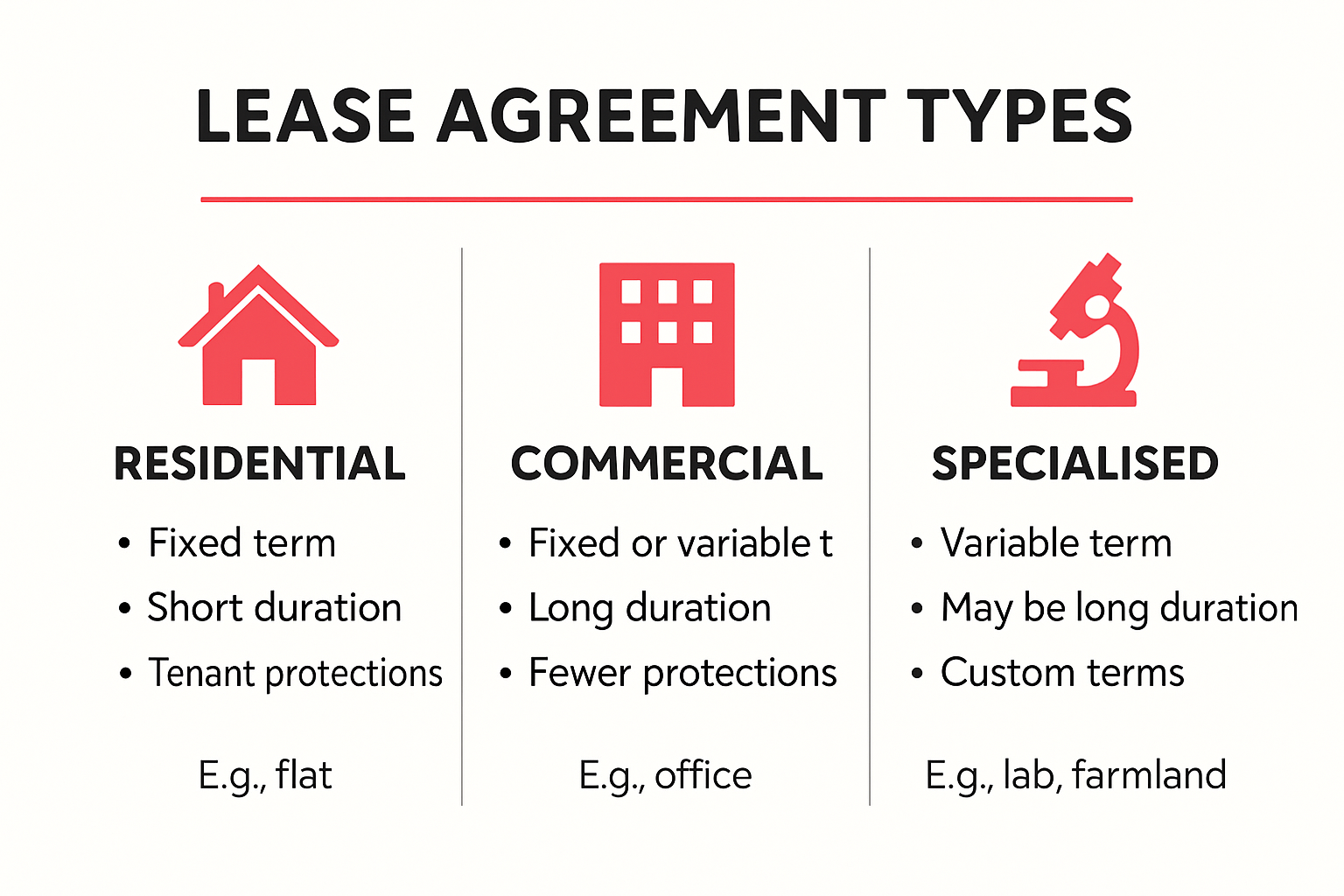|
Getting your Trinity Audio player ready...
|
Leasing a property is far more than just signing a few papers and handing over the keys. A standard lease agreement can include up to 10 detailed clauses covering everything from payment terms to tenant privacy rights. Most people assume these documents are dry and straightforward, but the reality is that a single overlooked line can turn a peaceful rental into a costly dispute. When you realise how much legal and financial complexity is tucked into one agreement, it changes how you look at property rentals altogether.
Table of Contents
- Defining A Lease Agreement: Key Features And Terminology
- The Importance Of Lease Agreements For Property Owners
- Understanding Obligations And Rights In A Lease Agreement
- Common Types Of Lease Agreements And Their Applications
- Real-World Context: How Lease Agreements Work In Sweden
Quick Summary
| Takeaway | Explanation |
|---|---|
| Define lease agreement essentials | Understand the core elements like property details, lease duration, and financial terms. |
| Clarify tenant and landlord roles | Clearly outline responsibilities, rights, and obligations for both parties to prevent disputes. |
| Utilise appropriate lease types | Choose between residential, commercial, or specialized leases based on specific rental needs. |
| Implement clear financial safeguards | Use lease agreements to specify payment terms and protect against potential financial risks. |
| Understand local leasing regulations | Familiarize yourself with the legal framework governing leases in your area for compliance and protection. |
Defining a Lease Agreement: Key Features and Terminology
A lease agreement represents a legally binding contract between a property owner (landlord) and a tenant that establishes the terms and conditions for occupying a specific property. Cornell Law School defines this contract as a mechanism through which one party conveys property or services to another for a specified duration, typically in exchange for periodic payments.
Essential Components of a Lease Agreement
A comprehensive lease agreement encompasses several critical elements that protect both the landlord and tenant’s interests:
- Property Details: Precise description of the leased property, including full address, unit number, and specific areas included in the rental
- Lease Duration: Clear start and end dates of the tenancy, specifying whether it is a fixed-term or month-to-month arrangement
- Financial Terms: Exact rental amount, payment schedule, accepted payment methods, and any associated fees or penalties
Legal Rights and Responsibilities
Lease agreements articulate the fundamental obligations and protections for both parties. These typically include:
- Tenant responsibilities such as maintaining the property, paying rent on time, and adhering to community guidelines
- Landlord obligations including property maintenance, ensuring habitability, and respecting tenant privacy rights
- Conditions for lease termination, security deposit handling, and potential remedies for contract breaches
Understanding these nuanced legal provisions is crucial for creating a transparent and mutually beneficial rental relationship. Learn more about our approach to corporate leasing to gain deeper insights into professional rental arrangements.
The Importance of Lease Agreements for Property Owners
Lease agreements play a critical role in protecting property owners’ financial interests and legal rights. Iowa State University Extension highlights that a well-structured lease provides clarity and prevents potential disputes between property owners and tenants.
Financial Protection and Risk Mitigation
A comprehensive lease agreement serves as a crucial financial safeguard for property owners. The document establishes clear expectations and legal recourse in various scenarios:
- Rent Collection: Specifies exact payment terms, due dates, and consequences of late or missed payments
- Property Damage Coverage: Outlines tenant responsibilities for maintaining property condition
- Security Deposit Management: Defines conditions for deposit return and potential deductions
Legal Compliance and Operational Security
Properly crafted lease agreements help property owners navigate complex legal landscapes and maintain professional relationships. Key operational benefits include:
- Establishing clear boundaries and expectations for tenant occupancy
- Protecting owner interests through legally enforceable terms
- Creating a standardised framework for property management
By implementing robust lease agreements, property owners can transform potential risks into structured, predictable rental experiences.

Explore our comprehensive guide to professional property leasing to understand how strategic leasing can optimise your property management approach.
Understanding Obligations and Rights in a Lease Agreement
Lease agreements delineate a comprehensive framework of rights and responsibilities for both tenants and property owners, establishing a structured relationship that balances legal protections and practical expectations. Understanding these mutual obligations is fundamental to maintaining a harmonious and transparent rental arrangement.
Tenant Obligations and Responsibilities
Tenants enter into a legally binding commitment with specific core responsibilities that extend beyond simply paying rent:
- Financial Compliance: Consistently paying rent on time and in full as specified in the lease agreement
- Property Maintenance: Keeping the rental property clean, reporting maintenance issues promptly, and preventing intentional damage
- Respecting Lease Terms: Adhering to occupancy limits, noise regulations, and restrictions on subletting or alterations
Landlord Rights and Legal Duties
Property owners have equally important rights and obligations that protect their investment while ensuring tenant welfare:
- Collecting rent and enforcing lease terms through legal channels
- Maintaining the property in a habitable condition with functional utilities and structural integrity
- Providing reasonable notice before entering the property and respecting tenant privacy rights
Navigating these complex interactions requires clear communication and mutual understanding. Explore our comprehensive guide to professional property management to gain deeper insights into creating balanced and effective lease agreements.
To clarify the distinct obligations for both tenants and landlords, the following table summarises their respective rights and responsibilities as highlighted in lease agreements.
| Party | Core Rights | Key Responsibilities |
|---|---|---|
| Tenant | Right to habitable premises and privacy | Pay rent on time, maintain property, follow lease terms |
| Landlord | Collect rent, enforce lease terms, enter property (with notice) | Keep property habitable, respect tenant privacy |
This table should help both landlords and tenants understand their mutual duties and protections at a glance.
Common Types of Lease Agreements and Their Applications
Consumer Financial Protection Bureau highlights that lease agreements vary significantly based on specific property types and rental needs, with each format designed to address unique scenarios and protection requirements for both property owners and tenants.

Residential Lease Agreements
Residential leases form the most common category of rental contracts, typically structured to accommodate individual and family housing needs:
- Fixed-Term Leases: Standard agreements with predetermined duration, usually 6 to 12 months
- Month-to-Month Leases: Flexible arrangements allowing easier termination with shorter notice periods
- Sublease Agreements: Specialized contracts permitting existing tenants to rent their space to secondary occupants
Commercial and Specialized Lease Formats
Beyond residential rentals, lease agreements extend into more complex professional and specialized domains:
- Retail space leases with unique provisions for business operations
- Industrial property agreements with specific maintenance and modification clauses
- Equipment leasing contracts for specialized machinery and technology
Discover insights into professional leasing strategies that can help you navigate the nuanced landscape of rental agreements effectively.
The following table offers a comparative overview of the main types of lease agreements discussed, including a summary of their primary applications and notable features.
| Lease Type | Typical Duration | Main Application | Flexibility |
|---|---|---|---|
| Fixed-Term Residential | 6-12 months | Individual and family housing | Low (fixed end date) |
| Month-to-Month | Indefinite (monthly) | Short-term, flexible housing needs | High (short notice required) |
| Sublease | Variable | Allowing secondary occupants (with approval) | Medium (with landlord consent) |
| Commercial | Variable (often years) | Business, retail, or professional property | Medium (depends on contract) |
| Equipment Leasing | Typically short to mid-term | Equipment or technology rental | High (contract dependent) |
Use this table to quickly distinguish which lease format may best suit your specific rental requirements.
Real-World Context: How Lease Agreements Work in Sweden
Swedish Legal Database defines lease agreements within a comprehensive legal framework that prioritizes tenant protections and clear contractual obligations. The Swedish approach to leasing distinguishes itself through robust regulations that balance property owner interests with tenant rights.
Residential Leasing Regulations
Swedish residential lease agreements operate under stringent national guidelines that ensure fairness and transparency:
- Regulated Rental Pricing: Many municipalities implement controlled rental pricing mechanisms
- Tenant Security: Strong legal protections against arbitrary evictions
- Long-Term Tenancy Rights: Mechanisms supporting stable, predictable housing arrangements
Corporate and Commercial Leasing Dynamics
For business and professional environments, Swedish lease agreements incorporate sophisticated provisions that reflect the country’s advanced commercial landscape:
- Precise documentation of property usage conditions
- Comprehensive maintenance responsibility definitions
- Clear frameworks for dispute resolution and contract modifications
Explore professional leasing strategies specific to the Nordic market to understand the nuanced approach to property agreements in Sweden.
Upgrade Lease Certainty and Stress-Free Property Performance
If you have ever struggled with unclear lease terms or faced disputes over responsibilities, you understand how crucial a robust lease agreement truly is. This article shows the vital importance of getting every detail right: from transparent financials to clear maintenance duties. At Guestly Homes, we have transformed these complex obligations into a seamless experience for both property owners and long-stay residents. Our fully managed service means you never worry about late payments or unclear handovers. We prioritise professionalism, legal clarity, and hands-off ease, ensuring your property operates at peak performance and your rental agreements protect your long-term interests. To see how our professionally structured leasing solutions elevate your rental journey, visit our main website.

Ready to stop guessing about lease coverage and start enjoying predictable income or frictionless stays? Discover how Guestly Homes combines detailed legal care with five-star standards. Take the next step and explore our service options today. Let us make your rental experience simpler, safer and more profitable—because peace of mind should be part of every agreement.
Frequently Asked Questions
What is a lease agreement?
A lease agreement is a legally binding contract between a property owner (landlord) and a tenant, outlining the terms and conditions for occupying a specific property in exchange for periodic payments.
What are the key components of a lease agreement?
Key components of a lease agreement include property details, lease duration, financial terms such as rental amount and payment schedule, legal responsibilities of both parties, and conditions for lease termination.
What are the responsibilities of tenants in a lease agreement?
Tenants are responsible for paying rent on time, maintaining the property, adhering to lease terms, and reporting any maintenance issues promptly.
How do lease agreements protect property owners?
Lease agreements protect property owners by establishing clear financial expectations, defining tenant responsibilities for property upkeep, and outlining the legal recourse available in case of disputes or breaches, ensuring operational security and compliance.



